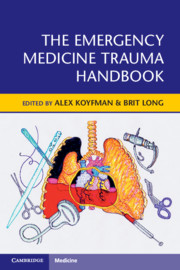Book contents
- The Emergency Medicine Trauma Handbook
- The Emergency Medicine Trauma Handbook
- Copyright page
- Contents
- Contributors
- Preface
- Disclaimer
- Chapter 1 General Approach to Traumatic Injuries
- Chapter 2 Trauma Airway
- Chapter 3 Transfusion in Trauma
- Chapter 4 Trauma in Pregnancy
- Chapter 5 Pediatric Trauma
- Chapter 6 Geriatric Trauma
- Chapter 7 Head Trauma
- Chapter 8 Facial Trauma
- Chapter 9 Eye Trauma
- Chapter 10 Cervical Spine Trauma
- Chapter 11 Thoracolumbar Trauma
- Chapter 12 Neck Trauma
- Chapter 13 Pulmonary Trauma
- Chapter 14 Cardiac Trauma
- Chapter 15 Abdominal and Flank Trauma
- Chapter 16 Genitourinary Trauma
- Chapter 17 Peripheral Vascular Injury
- Chapter 18 Pelvic Trauma
- Chapter 19 Upper Extremity Trauma
- Chapter 20 Lower Extremity Trauma
- Chapter 21 Burns and Electrical Injuries
- Chapter 22 Procedural Sedation and Analgesia in Trauma
- Chapter 23 Commonly Missed Traumatic Injuries
- Index
- References
Chapter 2 - Trauma Airway
Published online by Cambridge University Press: 23 August 2019
- The Emergency Medicine Trauma Handbook
- The Emergency Medicine Trauma Handbook
- Copyright page
- Contents
- Contributors
- Preface
- Disclaimer
- Chapter 1 General Approach to Traumatic Injuries
- Chapter 2 Trauma Airway
- Chapter 3 Transfusion in Trauma
- Chapter 4 Trauma in Pregnancy
- Chapter 5 Pediatric Trauma
- Chapter 6 Geriatric Trauma
- Chapter 7 Head Trauma
- Chapter 8 Facial Trauma
- Chapter 9 Eye Trauma
- Chapter 10 Cervical Spine Trauma
- Chapter 11 Thoracolumbar Trauma
- Chapter 12 Neck Trauma
- Chapter 13 Pulmonary Trauma
- Chapter 14 Cardiac Trauma
- Chapter 15 Abdominal and Flank Trauma
- Chapter 16 Genitourinary Trauma
- Chapter 17 Peripheral Vascular Injury
- Chapter 18 Pelvic Trauma
- Chapter 19 Upper Extremity Trauma
- Chapter 20 Lower Extremity Trauma
- Chapter 21 Burns and Electrical Injuries
- Chapter 22 Procedural Sedation and Analgesia in Trauma
- Chapter 23 Commonly Missed Traumatic Injuries
- Index
- References
Summary
Airway management is of paramount importance in trauma resuscitations; in fact, virtually all management algorithms begin with the assessment and protection of the airway. Trauma airways are often compromised and among the most difficult to manage due to hemodynamic instability from multi-organ dysfunction, cervical trauma, or direct trauma to airway structures.
- Type
- Chapter
- Information
- The Emergency Medicine Trauma Handbook , pp. 17 - 41Publisher: Cambridge University PressPrint publication year: 2019

